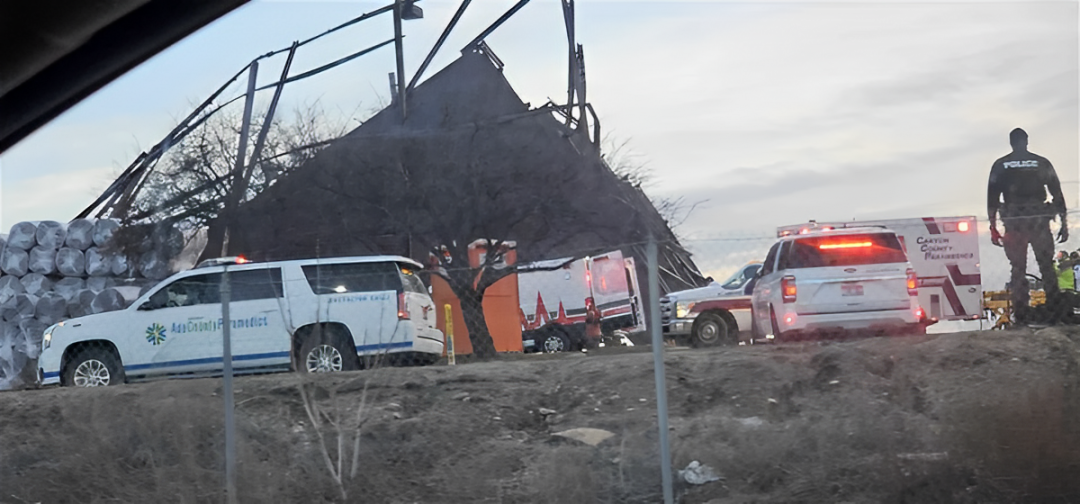The families of Mario Sontay and Mariano Coc, two construction workers who were tragically killed when an airport hangar at the Boise Airport collapsed, have filed a lawsuit against several companies involved in the construction. The lawsuit alleges that these companies recklessly cut corners and used inappropriate materials, leading to the fatal collapse.
The private hangar was still under construction when it collapsed on January 31 during high winds. The collapse resulted in the deaths of three people and injuries to nine others. Sontay, 32, and Coc, 24, had only been on the job for six days when the massive metal structure gave way. Their families have filed a wrongful death lawsuit against Big D Builders, Steel Building Systems, Inland Crane, and Speck Steel, seeking unspecified monetary damages.
According to the lawsuit, the problems with the construction were evident days before the collapse. Some subcontractors reported that the metal beams making up the skeleton of the building looked twisted or weren’t properly braced.
“Many subcontractors were critical of the rushed schedule,” the attorneys Enrique Serna and Jane Gordon wrote in the lawsuit. They cited “cutting of corners,” reported “bowing of beams,” snapping cables, a lack of key cross bracing, flange bracing, and cable bracing.
Big D Builders, based in Meridian, Idaho, declined to comment on the lawsuit. Both Inland Crane, based in Boise, and Steel Building Systems, based in Emmett, Idaho, expressed condolences to the families of the victims in written statements.
Inland Crane stated, “While we mourn the loss of our partners, friends, and colleagues, all evidence demonstrates that Inland Crane and our employees are not at fault for this tragedy.” Andy Speck, co-owner of SBS and Speck Steel, wrote, “Our heartfelt condolences go out to the victims and their families. We cannot speak to a majority of the complaints filed as SBS was not the installer of the metal building, nor did we possess or demonstrate any authority over job site operations.”
On the day of the collapse, Sontay and Coc were working on installing bolts to secure the building’s rafters, standing on a man lift that hoisted them 40 feet above the ground. The airport’s winds were stiff, reaching speeds between 25 and 35 miles per hour. Around 5 p.m., witnesses began hearing popping noises and a loud roaring sound.
Some workers inside the building managed to run to safety, but others were trapped. The lift holding Coc and Sontay was struck by a falling rafter and slammed into the ground. Coc, who had moved to the United States from Guatemala in 2020, died instantly. Sontay, also a Guatemalan citizen who came to the U.S. in 2021, succumbed to his injuries about five minutes later. Both men were supporting families in their home countries.

The lawsuit details significant safety concerns and alleged negligence on the part of the construction companies. It claims that Big D Builders had a set of construction plans approved by the city of Boise but chose to use a second set of plans designed by Steel Building Systems that required roughly 30% less bracing.
This deviation from the approved plans is central to the allegations of negligence. Furthermore, the building was constructed using a combination of prefabricated materials and locally manufactured bracing and structural supports that weren’t properly designed to fit the prefabricated pieces, resulting in serious design and engineering defects. These issues were exacerbated when strong winds began, leading to the catastrophic collapse.
On the day of the collapse, Inland Crane had removed three of the four cranes from the construction site, leaving an older model as the only erection support. This crane, according to the lawsuit, was not rated for high wind speeds and was improperly tied to the structure. “They know better! They know better than to act like this.
But a lot of the time, they think it’s going to be OK,” Serna, the attorney for the Coc and Sontay families, said at a press conference. “I hope these practices are not carried on because practices like this kill people. It clearly killed my clients.”
The Occupational Health and Safety Administration (OSHA) is still investigating the collapse. A report on the agency’s findings is expected to be released in the coming weeks, which may shed more light on the factors leading to this tragedy and possibly confirm the allegations made in the lawsuit.
Also Read:
- 7 States File Lawsuit Against Biden’s New Rule on Transgender Rights!
- Wild Neighbors: Boise Residents Reflect on Foothill Wildlife After Recent Incident!
- Search Continues for Two Missing After Boat Crash Near Galveston as Tropical Storm Approaches!
This lawsuit not only seeks justice for the families of Sontay and Coc but also aims to bring attention to the construction practices that allegedly led to the collapse. The case highlights the critical importance of adhering to safety regulations and approved construction plans, especially in high-risk projects such as large metal structures. As the legal proceedings unfold, the families hope that their actions will prevent future tragedies and hold those responsible accountable for their actions.



